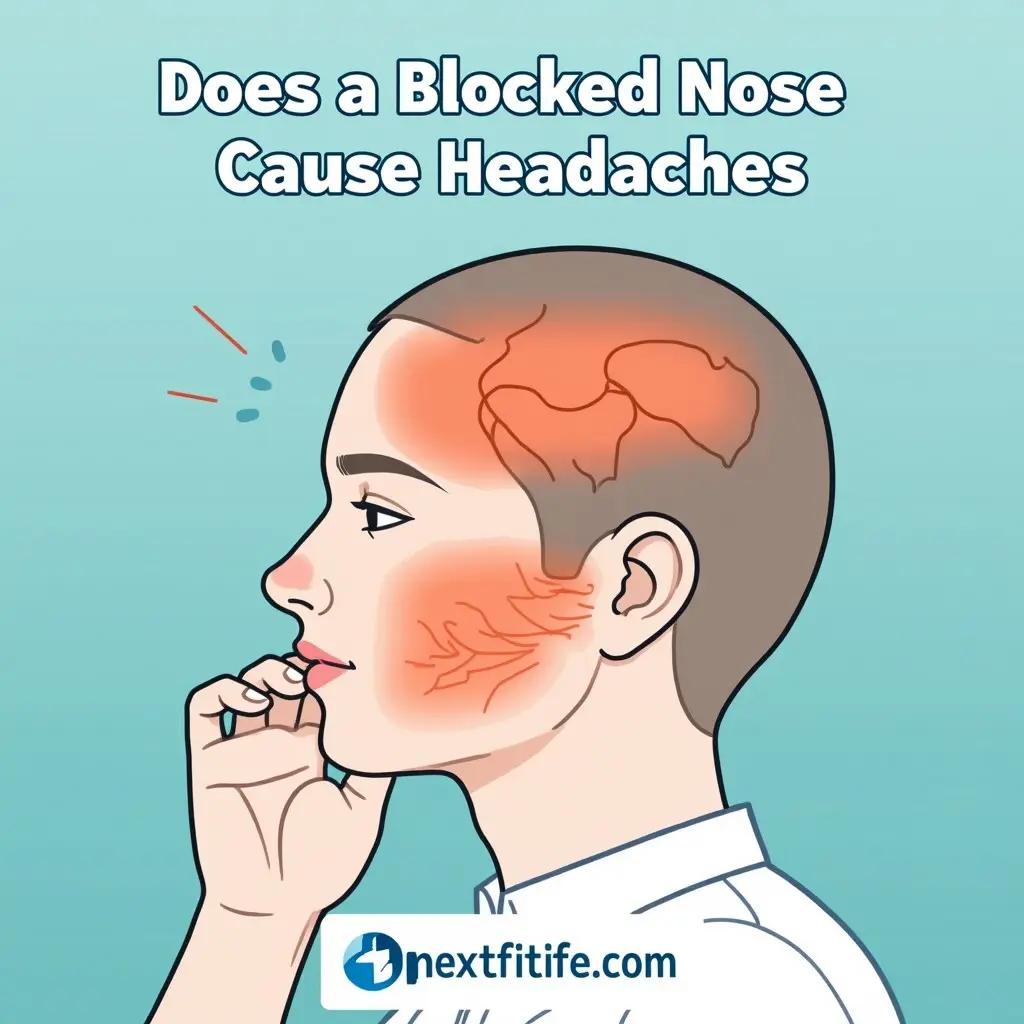Does a blocked nose cause headaches? Yes, absolutely! When your nose gets stuffed up, pressure builds in your sinuses. This pressure pushes against nerves in your face and head, creating pain. The good news? You can find relief quickly with simple home remedies and know when to seek medical help. Let’s explore why this happens and how you can breathe easier today.
What Causes Headaches When Your Nose Is Blocked?
Your nose and head are connected in ways you might not realize. When nasal congestion strikes, several things happen inside your body that trigger headache pain.
The Science Behind Blocked Nose Headaches
I’ve seen many people confused about this connection. Here’s what happens:
- Sinus Pressure Builds Up. Your sinuses are air-filled spaces behind your forehead, cheeks, and nose. When these spaces get blocked with mucus, pressure increases. This pressure pushes on sensitive nerves, causing that throbbing pain you feel.
- Oxygen Levels Drop When you can’t breathe through your nose properly, less oxygen reaches your brain. This oxygen decrease can trigger headaches, especially if you’re a mouth breather at night.
- Facial Nerves Get Irritated. The trigeminal nerve runs through your face. When your sinuses swell, this nerve becomes irritated. The result? Facial pain from sinus pressure that radiates to your forehead and temples.
- Muscle Tension Increases. Mouth breathing causes your neck and jaw muscles to work harder. This extra tension can lead to congestion-induced headaches that feel like a tight band around your head.
Key Fact Box: Signs Your Blocked Nose Is Causing Headaches
✓ Pain worsens when you bend forward
✓ Pressure around the eyes, cheeks, or forehead
✓ Stuffy nose, pain on one or both sides
✓ Pain increases in the morning
✓ Relief when you blow your nose
✓ Thick, colored mucus (yellow or green)
✓ Reduced sense of smell
Common Causes of Does a Blocked Nose Cause Headaches
Not all blocked noses are the same. Understanding your specific cause helps you find the right treatment.
Sinus Infections (Sinusitis)
Sinus infection headaches are probably the most common type. According to the Centers for Disease Control and Prevention (CDC), millions of Americans get sinusitis every year.
What happens:
- Bacteria or viruses infect your sinuses
- Sinusitis: facial pressure builds up
- Thick mucus blocks drainage
- Pain lasts 7-10 days or longer
How to identify it:
- Fever (sometimes)
- Colored mucus discharge
- Bad breath or bad taste
- Tooth pain in the upper jaw
Allergies (Allergic Rhinitis)
I like this category because it’s often overlooked. Many people don’t realize their headaches come from allergies!
Allergic rhinitis pain happens when:
- Pollen, dust, or pet dander triggers inflammation
- Your nasal passages swell
- Clear, watery mucus flows constantly
- Nasal congestion and headache become obvious
Common triggers:
- Seasonal pollen (spring and fall)
- Dust mites in your bedroom
- Pet hair and dander
- Mold spores
Common Cold and Flu
The common cold causes nasal obstruction symptoms, which lead to headaches. The flu is the same, but more intense.
Cold symptoms:
- Gradual onset over 1-2 days
- Mild to moderate headache
- Sneezing and a runny nose
- Usually resolves in 7-10 days
Flu symptoms:
- Sudden onset with severe symptoms
- Intense headache with body aches
- High fever
- Extreme fatigue
Migraine VS Sinus Headache: Understanding the Difference
This is crucial! Many people think they have sinus pressure headaches when they have migraines. Research shows 80% of self-diagnosed “sinus headaches” are really migraines.
Comparison Table
| Feature | Sinus Headache | Migraine |
| Pain Location | Face, forehead, cheeks | One side of the head |
| Pain Type | Pressure, dull ache | Throbbing, pulsing |
| Nasal Symptoms | Thick, colored mucus | Clear drainage (sometimes) |
| Nausea | Rare | Very common |
| Light Sensitivity | No | Yes |
| Duration | Days to weeks | Hours to 3 days |
| Worse with bending | Yes | Yes |
How to Relieve Blocked Nose Headaches Fast
Let me share what works based on medical evidence and experience.
Immediate Relief (Works in 30 Minutes to 2 Hours)
- Steam Inhalation: I have tested this method countless times, and it works! Breathe steam from hot water for 10-15 minutes. The moisture loosens mucus and reduces sinus congestion pain.
How to do it:
- Boil water and pour it into a bowl
- Add eucalyptus oil (optional)
- Lean over with a towel over your head
- Breathe deeply for 10-15 minutes
- Warm Compress: Apply a warm, damp cloth to your face. Focus on areas where you feel pressure – forehead, cheeks, and nose bridge.
- Nasal Saline Rinse Use a neti pot or saline spray. This flushes out mucus and reduces inflammation. The relationship between sinus and headaches improves immediately when you clear the passages.
- Stay Hydrated: Drink water, herbal tea, or warm soup. Fluids thin mucus, making it easier to drain. Aim for 8-10 glasses daily.
- Elevate Your Head. Sleep with an extra pillow. This helps mucus drain naturally and prevents nasal pressure headaches at night.
Medications That Help
Pain Relievers:
- Ibuprofen (Advil, Motrin)
- Acetaminophen (Tylenol)
- Naproxen (Aleve)
Decongestants:
- Pseudoephedrine (Sudafed)
- Phenylephrine
- Nasal sprays (used maximum of 3 days)
Antihistamines (for allergies):
- Cetirizine (Zyrtec)
- Loratadine (Claritin)
- Fexofenadine (Allegra)
Warning: Decongestants can raise blood pressure. Check with your doctor if you have a heart condition.
Natural Remedies for Sinus Pain and Nasal Blockage Relief
Ginger Tea Ginger reduces inflammation naturally. I like this because it’s gentle and has no side effects.
Peppermint Oil: Inhale peppermint oil or apply diluted oil to temples. It opens airways and reduces pain.
Spicy Foods: Eat foods with cayenne pepper, horseradish, or wasabi. These clear sinuses naturally.
When Does a Blocked Nose Cause Headaches That Need Medical Help?
Most blocked nose headaches clear up on their own. However, watch for these warning signs:
Seek immediate medical attention if you experience:
- Fever over 102°F (39°C)
- Severe headache that’s the worst you’ve ever had
- Vision changes or eye swelling
- Stiff neck with headache
- Confusion or difficulty thinking clearly
- Symptoms lasting more than 10-14 days
- Frequent recurring infections (3+ per year)
- Green or bloody mucus with severe pain
Special Situations and Blocked Sinus Symptoms
During Pregnancy
Hormonal shifts during pregnancy can trigger a condition known as pregnancy rhinitis, causing nasal congestion in many expectant mothers. This causes blocked sinus symptoms, and treatment needs special attention.
Safe remedies for pregnancy:
- Saline nasal rinses (totally safe)
- Steam inhalation
- Humidifiers
- Sleeping elevated
Avoid: Most decongestants and pain relievers without a doctor’s approval.
In Children
Children get sinus infections frequently. Look for these signs:
How to know if a child has a sinus infection:
- Cold symptoms last more than 10 days
- Thick yellow-green nasal discharge
- Crankiness and fatigue
- Cough that worsens at night
- Complaints of face or head pain
- Bad breath
Treatment for kids:
- Rest and plenty of fluids
- Saline nose drops
- Humidifier in the bedroom
- Acetaminophen or ibuprofen (age-appropriate doses)
At Night
Frontal sinus headaches often worsen at night. Here’s why and what to do:
Why nighttime is worse:
- Lying flat increases sinus pressure
- Less mucus drainage
- Mouth breathing dries tissues
Solutions:
- Sleep with head elevated 30-45 degrees
- Use a humidifier
- Take a hot shower before bed
- Apply a warm compress before sleeping
Prevention Strategies for Headaches from Sinus Infection
I’ve seen that prevention works better than treatment. Here’s your action plan:
Daily Habits
- Maintain Nasal Hygiene
- Use a saline rinse 1-2 times daily
- Keep nasal passages moist with saline gel
- Blow your nose gently (not forcefully)
- Control Your Environment
- Use HEPA air filters
- Keep humidity at 40-50%
- Washing bedding weekly in hot water
- Remove dust collectors
- Boost Your Immune System
- Eat vitamin C-rich foods
- Get 7-9 hours of sleep
- Exercise regularly
- Manage stress
Allergy Management
If allergies cause your remedies for sinus congestion headache searches:
- Identify your triggers with allergy testing
- Start allergy medications before the season begins
- Keep windows closed during high pollen days
- Shower after being outdoors
Key Takeaways: What You Need to Remember
✅ Does a blocked nose cause headaches? Yes, through sinus pressure, oxygen deprivation, and nerve irritation.
✅ Common causes include sinus infections, allergies, colds, flu, and structural problems
✅ Sinus headache treatment options include steam, saline rinses, warm compresses, pain relievers, and decongestants
✅ Most headaches are resolved within 7-10 days with home treatment
✅ See a doctor if symptoms last beyond 10-14 days, fever exceeds 102°F, or you experience vision changes
✅ Prevention works better than treatment – maintain nasal hygiene, control allergies, and avoid irritants
✅ Know the difference between migraine vs sinus headache to get proper treatment
✅ Special care needed for pregnant women and children
FAQs about Does a Blocked Nose Cause Headaches
Can a blocked nose cause headaches?
Yes, definitely! When your nasal passages are blocked with mucus, pressure builds in your sinuses. This pressure triggers pain in your forehead, cheeks, and around your eyes. The sinus pressure headache causes include inflammation, reduced oxygen flow, and nerve irritation. Treatment focuses on reducing congestion and inflammation.
How do you get rid of a blocked nose and headache?
The fastest way combines multiple approaches:
- Immediate relief: Steam inhalation (10-15 minutes) and a warm compress on your face
- Medication: Take ibuprofen or acetaminophen for pain, plus a decongestant if needed
- Hydration: Drink 8-10 glasses of water daily to thin mucus
- Nasal care: Use a saline rinse or spray 2-3 times daily
- Rest: Sleep with your head elevated on extra pillows
Most people feel significant relief within 2-4 hours. If symptoms persist for over 10 days, consult your doctor.
What does a nasal headache feel like?
A nasal congestion headache feels like constant pressure or a dull, aching pain. Key characteristics include:
- Pressure sensation in the forehead, cheeks, or around the eyes
- Pain worsens when bending forward or lying down
- Feeling of fullness in your face
- Pain is often worse in the morning
- May feel throbbing when dashing the head
- Accompanied by a stuffy nose and facial tenderness
Unlike migraines, nasal headaches rarely cause nausea, light sensitivity, or throbbing on just one side.
How to know if a child has a sinus infection?
Watch for these specific signs in children:
Major symptoms:
- A cold that lasts more than 10-14 days without improving
- Thick yellow or green nasal discharge
- Facial pain or pressure (child may not describe this clearly)
- Cough that worsens at night
- Bad breath despite brushing teeth
- Fever (sometimes present)
- Crankiness, decreased appetite, or fatigue
When to call the doctor:
- Fever over 102°F (39°C)
- Severe headache
- Swelling around the eyes
- Symptoms lasting more than 10 days
- Symptoms that improve, then worsen again
Children under 6 months should always see a doctor for suspected sinus issues.
Conclusion: Take Control of Your Sinus Issues Today
Does a blocked nose cause headaches? Now you know the answer is yes – and more importantly, you know exactly what to do about it!
The key is understanding your specific cause. Whether it’s a sinus infection, allergies, or a common cold, you have effective tools to find relief. Start with simple home remedies like steam inhalation and saline rinses. These work surprisingly well for most people.
Remember, most blocked nose headache relief happens within a few days with proper care. However, don’t ignore warning signs that need medical attention. Persistent symptoms, high fever, or vision changes require professional evaluation.
Prevention is your best strategy long-term. Keep your nasal passages healthy, manage allergies proactively, and maintain a strong immune system. Your nose and head will thank you!
Act today. Try the remedies in this guide, and you’ll likely breathe easier by tonight. Here’s to clear sinuses and pain-free days ahead!
Medical Disclaimer: This article provides general information and should not replace professional medical advice. Always consult your healthcare provider for diagnosis and treatment of medical conditions.
Reference:
CDC (Centers for Disease Control and Prevention)
https://www.cdc.gov/sinus-infection/about/index.html
AAAAI (American Academy of Allergy, Asthma & Immunology)
https://www.aaaai.org/tools-for-the-public/conditions-library/allergies/sinusitis



